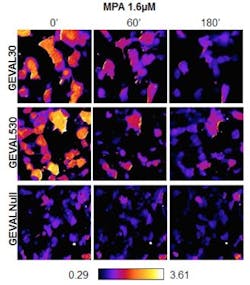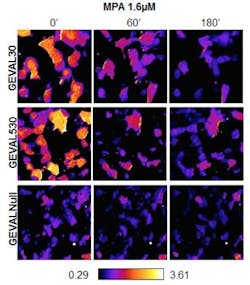Fluorescent sensors show promise for new cancer therapies
Recognizing that there is no way to monitor the important GTP nucleotide in live cells and to understand—and disrupt—its contribution to tumor growth and aggressiveness, a team of researchers at the Roswell Park Cancer Institute (Buffalo, NY) and collaborators has developed genetically encoded GTP fluorescent sensors that can rapidly detect changes in GTP levels in living cells. The finding could enable development of new approaches for treating a wide variety of solid-tumor cancers and perhaps other diseases, the researchers say. The fluorescent sensors—which the team refers to as GEVALs, or GTP evaluators—rely on fluorescent protein technology.
Related: Roswell Park wins $10.2 million for photodynamic therapy research for cancer treatment
"GTP plays an essential role in multiple cellular processes, including protein synthesis, cytoskeleton maintenance and function, nuclear and intracellular transport and intracellular signaling," explains Anna Bianchi-Smiraglia, Ph.D., a postdoctoral researcher with the Department of Cell Stress Biology at Roswell Park and the first author of a paper that describes the work. "By inserting a yellow fluorescent protein into a particular bacterial protein and monitoring the comparative change in fluorescence that results when GTP binds to our sensors, we are able to detect and track changes in GTP levels," she says.
These GEVAL sensors for GTP measurement can be performed in live cells, and reveal the spatiotemporal dynamics driving changes in GTP levels and activity.
"Our sensors represent a new and unique tool for assessing changes in GTP levels in cell populations and individual cells, which may in turn point the way to effective strategies for suppressing or even preventing tumor growth," says Mikhail Nikiforov, Ph.D., Professor of Oncology in the Department of Cell Stress Biology at Roswell Park and the paper's senior author. "This is an early finding that will have to be further developed through additional research, but it suggests opportunities for developing therapies that interfere with GTP metabolism by targeting key enzymes—perhaps existing therapies as well as new drugs yet to be developed."
The team's collaborators include scientists from the University of Texas Health Science Center at San Antonio.
Full details of the work appear in the journal Nature Methods.

